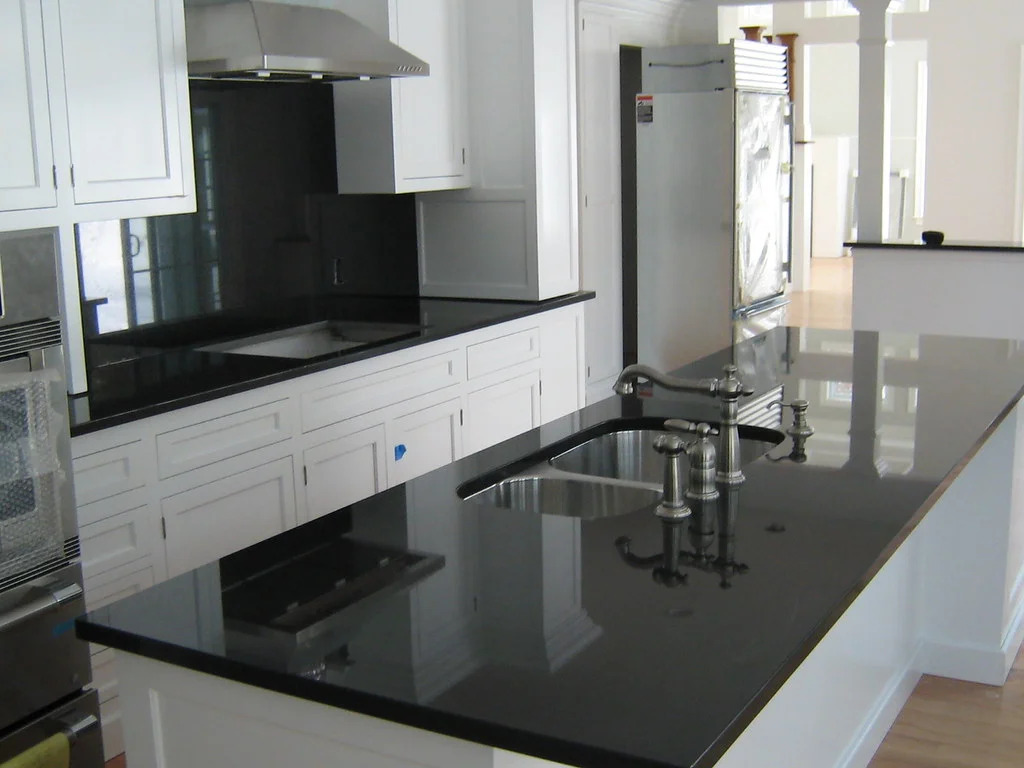Absolute Black is prized for its dramatic, near-solid black field — but its perfect-looking finish also shows streaks, fingerprints and water spots more readily than patterned stones. The good news: proper daily care, occasional sealing checks, and conservative stain treatments keep the finish flawless without abrasive scrubbing or harsh chemicals. This guide gives step-by-step cleaning routines, rescue methods for stains, finish-specific tips (polished vs. honed vs. leathered) and what to avoid — all backed by trade and industry sources.
What makes Absolute Black special
Absolute Black is a dense, fine-grained dark igneous dimension stone that polishes to a deep, uniform black. That uniformity is what makes it striking — and what makes smudges, oil, and water spots visible on a polished surface. Honed and leathered finishes hide marks better but have different maintenance needs (honed is more “matte,” leathered has a textured finish that conceals fingerprints).
Daily cleaning: simple, safe, effective
What you need (daily kit)
- Microfiber cloth or soft cotton towel.
- Spray bottle with warm water and a couple drops of mild dish soap (pH-neutral).
- Soft non-scratch sponge or soft nylon brush (for textured finishes).
- Commercial pH-neutral stone cleaner (optional, for routine use).
Step-by-step daily routine (polished and honed)
- Remove crumbs/dry debris with a soft dry cloth or dusting microfiber. (Dry grit can abrade the finish.)
- Spray a mild soap + warm water solution (or a labeled pH-neutral stone cleaner) and wipe with a damp microfiber cloth in small circular motions. Rinse cloth and wipe again to remove residue.
- Dry and buff immediately with a second dry microfiber cloth to avoid water spots and streaks — especially important for Absolute Black’s polished faces.
Why this works: pH-neutral cleaners and soap are safe for the stone and for most sealers; they lift oils and soils without dissolving sealants or etching mineral phases. Acidic cleaners (vinegar, lemon), strong alkalis (undiluted ammonia), and harsh solvents will accelerate sealer breakdown or dull the finish.
Weekly & monthly care: checks and light maintenance
Weekly: Wipe the whole work area, paying attention to seams and cutouts where crumbs collect. For textured (leathered) finishes, use a soft nylon brush to lift trapped particles, then rinse and dry.
Monthly: Run a water-drop test on an inconspicuous spot to check seal integrity (if your slab is sealed): place a few drops of water; if it beads, the sealer is likely fine; if it soaks in, plan a reseal. Manufacturers and trade bodies give reseal guidance that varies with stone and sealer — typical re-seal intervals reported range from 1 year to 10+ years depending on product and use. Verify with your supplier.
Stain rescue: how to treat common spills safely
Immediate action for all spills: blot (don’t rub) with a paper towel, then clean with mild soap + water and dry. Prompt blotting prevents many stains from setting.
Oil/grease (cooking oil, butter)
Blot excess. Apply a poultice (absorbent powder — kaolin, diatomaceous earth, or baking soda — mixed with a few drops of a mild solvent like acetone or a stone-safe cleaner to a peanut-butter consistency). Cover with plastic and tape edges; leave 24–48 hours; remove dry poultice and rinse. Repeat if needed. Use a commercial poultice recipe for stubborn oil.
Organic stains (coffee, tea, wine)
Blot. Clean with warm water and mild pH-neutral soap. For stubborn marks, a poultice with hydrogen peroxide (low concentration) may be used on light-colored stains; test an inconspicuous area first and follow manufacturer guidance.
Rust or metal marks
Use a manufacturer-approved rust remover formulated for natural stone, or hire a stone restoration professional — rust often requires specific chemistry and may need professional attention.
Disinfecting (occasional use)
If you must disinfect (e.g., after raw poultry contact), use a diluted bleach solution only on well-sealed granite and rinse thoroughly: Clorox recommends ~⅓ cup bleach per gallon of water for disinfecting surfaces and immediate rinsing afterward. Because bleach and harsh disinfectants can degrade some sealers, prefer soft bleach dilutions and avoid frequent use; verify your sealer’s tolerance with the supplier.
Caveat on bleach and harsh chemicals: many stone pros and trade groups advise avoiding routine use of bleach, ammonia, or strong acids because they can degrade sealers and dull finishes over time. If you use bleach for disinfection, dilute, rinse promptly, and test on an inconspicuous area first.
What to never use on Absolute Black granite
- Vinegar, lemon, or other acidic cleaners — acids can attack some minerals and break down sealers.
- Abrasive pads or powders (scouring pads, melamine foam) — they scratch and dull polished black surfaces.
- Undiluted bleach, undiluted hydrogen peroxide, or ammonia-based cleaners routinely — these can harm sealers and finish. Occasional, careful, diluted use for disinfection is acceptable if the stone is sealed and fully rinsed afterward; otherwise avoid.
- Hydrofluoric-acid containing rust removers — HF attacks silicates and can severely damage stone. Always check product ingredients.
Finish-specific tips: polished vs. honed vs. leathered
Polished Absolute Black
Shows fingerprints and water spots most readily. Dry and buff after cleaning for the best look. Use soft clothes and avoid abrasive cleaners.
Honed Absolute Black
Matte finish highlights oils differently; it can reveal fingerprints more but is less glarey. Use gentle soap and more frequent sealing for honed surfaces, because they are microscopically more open than polished.
Leathered Absolute Black
Textured surface hides marks well but traps crumbs and oils in the texture — clean with a soft brush and rinse regularly. Leathered finishes can be harder to restore if damaged.
Sealing: when and how (and why it matters)
Do you need to seal Absolute Black? Many Absolute Black slabs are dense and low-absorption, but sealing still adds a layer of stain protection — the Natural Stone Institute recommends considering sealer use and notes many sealers have life expectancies up to 10–15 years depending on product and use. Test and reapply when the stone absorbs water (drop test).
How to reseal: Clean the slab thoroughly, allow it to dry completely (24–48 hours depending on climate), apply the manufacturer-recommended sealer evenly, wipe excess, and follow the sealer’s cure time. Always use products labeled for natural stone and match sealer type (impregnating vs topical) to your needs; impregnating (penetrating) sealers are common for countertops.
When to call a professional
- Deep, set-in oil or rust stains after home poulticing.
- Large chips, fractures, or areas where a finish needs re-polishing or re-leathering.
- If you suspect the slab was surface-dyed or treated and you’re seeing fading or unevenness — pros can test and advise.
Safety & chemical disclaimer
If you are dealing with hazardous chemical exposure (fumes, mixing bleach with ammonia) or large-scale remediation, consult a qualified professional or contact your local poison control center or occupational safety authority. Never mix cleaning chemicals (bleach + ammonia/vinegar) — that can produce toxic gases.
Conclusion
Absolute Black looks spectacular when cared for correctly. Use mild, pH-neutral cleaning, blot spills fast, test and reseal when water no longer beads, and avoid abrasive or strongly acidic/alkaline cleaners that degrade sealers and finishes.
About BBV Impex
BBV Impex is a leading marble and granite exporter & supplier known for its honesty, consistency, and deep understanding of natural stones. We source our materials directly from trusted quarries and deliver carefully processed slabs and blocks to clients worldwide. Our team believes in long-term relationships built on trust, quality, and commitment. From classic marbles to durable granites, every stone we supply carries the mark of fine craftsmanship and natural beauty. At BBV Impex, we don’t just trade stones — we help builders, architects, and homeowners bring their design ideas to life.

